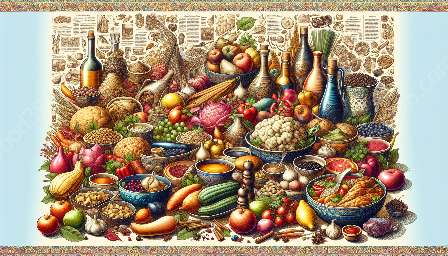Early agricultural practices played a pivotal role in shaping the establishment of social hierarchies and power structures. As societies shifted from nomadic hunting and gathering to settled agricultural lifestyles, the way food was produced, distributed, and consumed underwent significant transformations, ultimately impacting social organization and power dynamics. This topic cluster explores how early agricultural practices contributed to the establishment of social hierarchies and power structures, as well as their influence on the development of food cultures and the origin and evolution of food culture.
The Transition to Agriculture and Surplus Food Production
The advent of agriculture marked a fundamental shift in human subsistence strategies. Instead of relying on foraging for food, early human communities began cultivating crops and domesticating animals, leading to the accumulation of surplus food. This surplus allowed for the sustained feeding of larger populations and provided the opportunity for the emergence of non-food-producing specialist roles within societies.
Specialization and Trade
With surplus food production, individuals were able to specialize in activities other than food procurement, such as craftsmanship, warfare, and governance. This specialization, in turn, led to the development of trade networks as communities sought to exchange their surplus agricultural produce and specialized goods with neighboring groups. Trade facilitated the acquisition of resources, technologies, and exotic foods, contributing to the diversification of food cultures and the establishment of economic relations.
Formation of Complex Societies
The ability to produce surplus food and engage in trade laid the groundwork for the rise of complex societies. Hierarchies began to form, with some individuals gaining control over resources, land, and labor, and assuming leadership roles. The distribution of surplus food allowed these individuals to consolidate their power and influence, giving rise to early forms of social stratification and power structures.
Impact on Food Cultures
Food Symbolism and Rituals
As agricultural societies developed, food became more than just sustenance; it took on symbolic and ritualistic significance. Certain foods became associated with status, religious ceremonies, and communal gatherings, shaping the cultural identity of different social groups. The cultivation of specific crops and the rearing of particular animals also influenced the formation of distinct culinary traditions and regional food cultures.
Food as a Marker of Social Status
The availability of surplus food allowed for the differentiation of diets based on social status. Elites often consumed luxury foods and exotic imports, while the general populace relied on staple crops and locally sourced ingredients. This distinction in food consumption became a visible marker of social stratification and reinforced existing power structures.
Origin and Evolution of Food Culture
Domestication and Culinary Innovations
Early agricultural practices, including animal domestication and crop cultivation, sparked culinary innovations and the development of cooking techniques. As societies began to cultivate and process a variety of foodstuffs, culinary traditions evolved, resulting in the emergence of diverse food cultures. The domestication of plants and animals also laid the foundation for the integration of new flavors, ingredients, and cooking methods into regional cuisines.
Global Exchange of Food and Ideas
Through trade and exploration, agricultural societies engaged in the global exchange of foodstuffs and culinary practices. This exchange facilitated the spread of crops, spices, and cooking methods across different regions, leading to the enrichment and fusion of food cultures. The interconnectedness of early agricultural societies catalyzed cross-cultural influences and the adaptation of foreign foodways, contributing to the evolution of food culture on a global scale.


